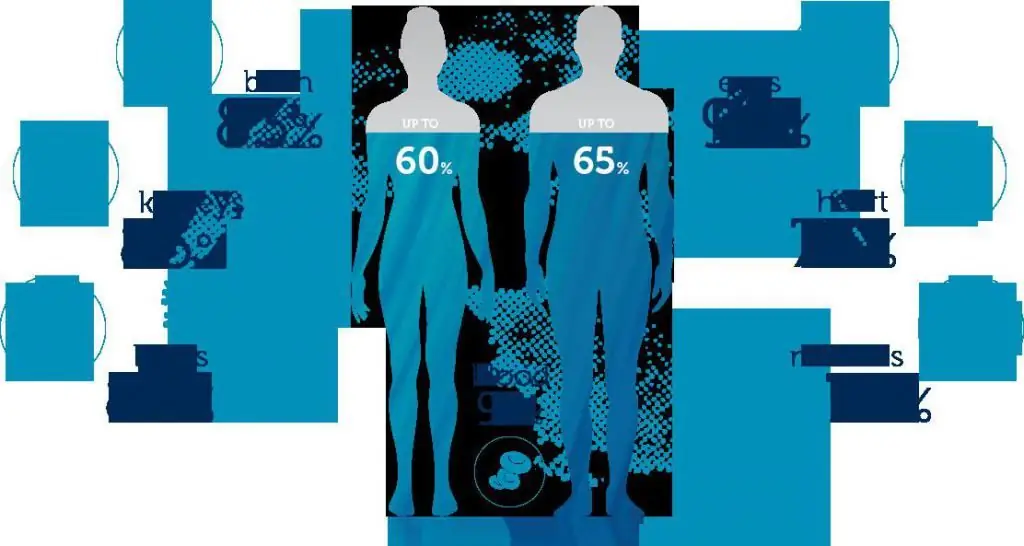2026 Author: Priscilla Miln | [email protected]. Last modified: 2025-01-22 17:55:15
All parents strive to teach their baby various skills as early as possible. But neither their patience, nor pedagogical skills and perseverance can force children to perform certain actions. For example, they do not want to chew solid food. What to do in such a situation? How to teach him to chew and swallow?
Parents should make sure that the skill and ability of chewing in the child is formed at the right time and correctly. To do this, they should be aware of the possible causes of the lack of ability to chew and the methods of formation of this reflex. The answer to the question of when and how to teach a child to solid food can be found in the article.
Benefits of solid foods
Pediatricians believe that the later the child begins to chew lumps, the more problems he may have.
Late transition to solid foods threatens to cause the following problems:
- Misaligned bite.
- Disturbances in the digestive system.
- Violation of the speech function, sincechewing muscles are also involved in the pronunciation of words.
- Psychological disorders. At 2-3 years old, when the baby is already aware of his actions, he may generally refuse to take solid (not ground) food.
Age periods of chewing reflex formation

When to introduce solid foods to a child's diet? You need to teach your baby to chew in stages, since a sharp transition from mushy food to hard and hard food can cause food refusal and stress.
Doctors say babies over 10 months old should no longer choke on food. If this happens, then this symptom signals parents about he alth problems.
Conventionally, the stages of development of the reflex are divided into 3 categories:
- 6 months - 1 year is the ideal time to introduce complementary foods. You should start the process with very liquid cereals and mashed potatoes. The baby during this period tries to taste the food, he performs a variety of movements with his jaws and lips. From 8 months, small pieces of food can be left in the puree, the size of which needs to be increased over time.
- 1 - 2 years - at this age, the average child has 8 teeth. His curiosity about solid food should be encouraged in every possible way. Some parents continue to give mashed potatoes, but overprotection in this case only harms the baby, if you do not start introducing him to hard pieces, then in the future it will be very difficult to do.
- From the age of 2, a child should be able to chew solid food (vegetables, fresh fruits, meat) well. It was during this periodbite begins to form and masticatory muscles develop. The baby's body remembers how much saliva and gastric juice needs to be produced. If by this time the child has not learned to chew, you should visit a doctor.
Possible problems

How to teach a child to solid food, what problems can arise in the process of accustoming? A child who is accustomed to eating only liquid food does not immediately perceive solid food. He starts spitting out food, turns away, acts up. When you try to feed him food with a firmer consistency, the following problems occur:
- The child refuses food, he is too lazy to chew.
- Too sharp a transition can scare him, he will not understand what to do with the pieces.
- When eating, the child chokes - it is simply unusual for him to swallow solid food, over time he will learn to control his tongue. Parents should give new products after the main feeding, a well-fed child will not rush to satisfy his hunger, but calmly try the new product, getting to know the new taste and texture.
- When trying to swallow, vomiting occurs. This is due to improper feeding technique - a spoon is inserted too deeply into the mouth. In addition, the volume of a baby spoon should not be more than 3 ml. If vomiting attacks are very frequent, you should consult a neurologist.
- The child is afraid to chew and swallow. Every child's fear has a reason. Probably, he had choked heavily before, or bitter medicine was given from this spoon. You should contact a child psychologist and pediatrician. In addition, you should not give medicine from the same spoon and then feed it with food, children remember little things well, perhaps he refuses not to eat, but to eat from this spoon.
To overcome the gag reflex, you should do a certain massage. Use a napkin that touches the tongue, and the child should strive to push it out with the help of the tongue. So he gets used to the new sensations and will not experience the urge to vomit when feeding.
When does a baby start eating solid foods and when should one start to worry?
The chewing reflex is formed from about 7 months, when teeth begin to erupt. It is at this time that the child makes the first attempts to bite everything and pulls surrounding objects into the mouth. This period of development of the baby is the time when the child is given solid food. That is, this is a signal to parents when to start introducing solid lumps into the diet. It is best to start with liquid cereals and mashed potatoes.
- By the age of one, the child is able to chew small pieces on his own;
- At 2 years old, a child calmly chews and swallows any food.
If your baby has not developed a chewing reflex by the age of 2, you should contact your pediatrician.
Causes of the problem

How to accustom a child to solid food, what problems hinder this process? There are several reasons that hinder the improvement of the chewing reflex, most of them can be eliminated at home.
Main causes of difficultyin chewing:
- Impatient parents. Solid food training is a long process, some moms and dads get bored with the baby, they give him the food he is used to so as not to waste time.
- Fear of parents that the child might choke. Many mothers begin to accustom to adult food late, fearing that the child will choke. In the future, this leads to even greater problems in the formation of this skill.
- Uncomfortable for the baby spoon. It is best to buy a small children's spoon made of silicone with a bright pattern. It is very comfortable, does not injure the enamel of the first teeth.
- Hyperactivity of the child - it is difficult for such children to concentrate on the process of chewing and swallowing. They begin to act up and demand food that is familiar to them, for which they do not need to spend extra effort.
- Lack of teethers in a child. With them, he learns to chew and he forms the correct bite.
- Failure by parents to accustom the child to solid food. It should be taught gradually. If abruptly switched to solid food, this can provoke frequent whims.
When can I start introducing solid foods?

From the moment the introduction of complementary foods begins, the child should be taught to eat a homogeneous and grated puree. The baby still has an immature digestive system and no teeth. In addition, up to 6 months of age, they have developed the ejection reflex, which protects them from accidentally swallowing objects.
When and how to teach a childchew solid food? It is not worth introducing complementary foods before 6 months, it will push food out, the process of feeding can lead to vomiting. But over time, he begins to taste hard pieces. This occurs when he begins to cut his teeth and there is a desire to scratch the gums. Parents should be very careful. Giving your baby bread and cookies is extremely dangerous - he can choke. How to teach a child to eat solid food?
How to understand that he is ready to chew? Baby is ready for solid food if:
- The kid looks with interest at the plates of adults, tries to take pieces from them.
- If he puts a spoon in his mouth and it doesn't make him gag.
- If while feeding mashed potatoes, he does not suck it, but takes it off the spoon with his lips.
These are the main signals that tell parents that the baby is ready for hard pieces. Usually training starts at 8-10 months. Before this period, it is extremely dangerous to give a child solid food. During feeding, you should be nearby and not leave the baby for a second.
How do I get my baby to eat solid food?

Doctors recommend starting the process of developing a baby's chewing skill at an early age. Ways to help facilitate the learning process:
- Using a nibbler is a special strainer in which you need to put a fruit or vegetable. Through it, he will be able to safely suck food, taste, chew without the threat of choking on a piece.
- Calmness and patience of parents. It is forbiddennervous, scolding the baby, yelling at him if he doesn’t succeed. Care should be taken that he is comfortable and the food leaves only positive impressions.
- Buy a baby teether - it helps to scratch the gums and forms a chewing reflex.
- How do I transition my baby to solid food? The gradual teaching of the baby to chew solid food. You need to start with mashed potatoes, then knead the food with a fork, gradually accustom him to eating a more solid consistency. Less homogeneous food, with smaller pieces, contributes to the process of learning to chew.
- From the age of 1, give the child small pieces of vegetables and fruits in the hand.
- You should introduce the baby to the cooking process. You can offer him to knead his own food with a fork, he will soon get tired of this process and he will begin to take pieces and chew them.
- From the age of 1, a baby should be put at an adult table so that he watches how his parents and other family members eat food and learns to be independent.
If there is no appetite
How to teach a child to chew solid food if he refuses to eat? It happens that the baby refuses solid food due to lack of appetite. Then the main task of mom and dad is not only teaching the baby to chew, but also stimulating interest in the process of eating food.
Ways to stimulate appetite:
- Organize your child's leisure time so that he moves more.
- Give him rosehip broth instead of juice. Remove snacks from the diet.
- Serve food on bright dishes, decorate the dishcolorful fruits and vegetables. Do not indulge the whims of the child, but do not scream, do not scold if something does not work out for him.
If a 2 year old doesn't want to eat solid food
How to teach a child to swallow solid food if at the age of 2 he does not know how to do this and does not want to eat "adult" food? If the baby is not able to chew and swallow by the age of two, you should contact your pediatrician. If, after consultation, the child is found to be absolutely he althy, the problem should be sought elsewhere.
The most common ones:
- Late transition to adult food.
- Overprotection of parents.
- Parents busy.
- Hyperactive child.
In such a situation, parents need to stock up on calmness, patience and teach the baby to chew and swallow, explaining how to do it.

Child does not want to chew
There are times when the baby does not agree to eat anything but mashed potatoes. It is especially bad when a child aged 1.5-2 does this, he has already formed habits and does not want to change them.
- If he eats fruit with pleasure, but does not want soup, the reason may be the number of teeth the baby has. If he has less than 8 teeth, he simply has nothing to chew on.
- Sometimes avoiding solid food is pedagogical. It simply tests the boundaries of acceptable behavior. You should be patient, do not panic and give him the same food after a while.
- You should invite him to choose what he wants to eat. Soup or porridgethe right to choose forms an interest in food in the baby.
Helpful tips for parents

And finally, we will give some recommendations to parents who begin to accustom the baby to “adult” food:
- Gradually add pieces of solid food to grated food in a blender.
- Make sure the child does not lose interest in food.
- Involve your baby in the cooking process.
- You can offer him to eat something sweet and tasty, for example, marmalade.
- Sit him at an adult table, he will see what kind of food everyone around eats and start imitating the rest of the family.
The main thing is to be patient and not stop halfway. The work will not be in vain, after a while the baby will begin to gobble up food on his own and with great pleasure.
Recommended:
How to teach a husband a lesson for disrespect: advice from psychologists. How to teach a husband to respect his wife

Do you have family problems? Has your husband stopped noticing you? Does he show indifference? Changes? Drinking? Beats? How to teach a husband a lesson for disrespect? The advice of psychologists will help to understand this issue
Plan of work in the preparatory group with parents. Reminder for parents. Advice for parents in the preparatory group

Many parents believe that only teachers are responsible for the education and upbringing of a preschooler. In fact, only the interaction of preschool workers with their families can give positive results
How to teach a child to think for himself? How to teach a child to think

Logical thinking does not come by itself, you should not, sitting at the TV, expect that it will appear in a child with age. Parents and teachers face the challenge of how to teach a child to think. There is a daily work to be done, consisting in cognitive conversations, reading books and various exercises
How to teach a child to drink water: maintaining the water balance in the child's body, advice from experienced parents and recommendations from doctors

Physiologists in their studies have proven that the human body is 70-90% water, and its lack is fraught with dehydration, which leads not only to diseases, but also to malfunctions of organs. How to teach a child to drink water if he does not want to? First, be disciplined and lead by example. As the saying goes, it takes 21 days to form a habit. Make a rough schedule and drink water together. You can add an element of the game by inviting the child to drink water at speed, who is faster
Child does not study well - what to do? How to help a child if he does not study well? How to teach a child to learn

School years are, without any doubt, a very important stage in the life of every person, but at the same time quite difficult. Only a small part of children is able to bring home only excellent grades for the entire period of their stay in the walls of an educational institution

